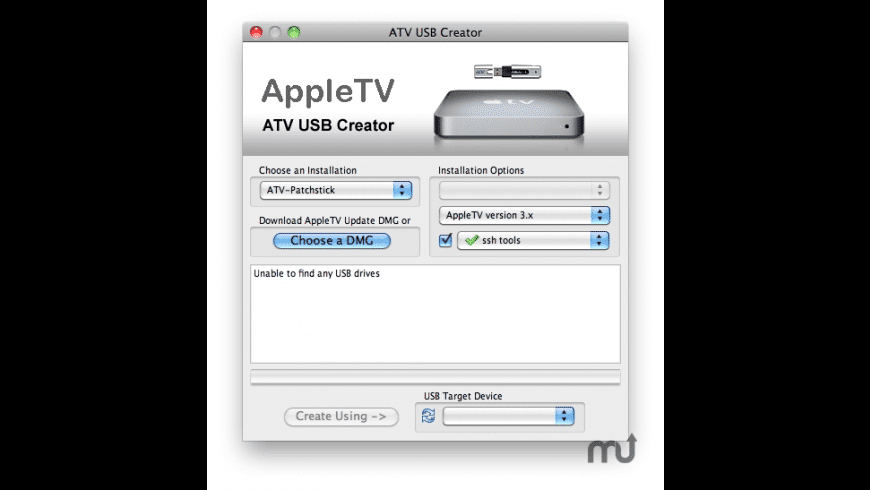One final note (sure, sure), Both XBMC and Boxee are net installed from XBMC/Boxee launcher so remember to first select 'Update' and install the individual applications. Oh yes, atvusb-creator can be found in the downloads section so have at it and enjoy XBMC and Boxee native on the AppleTV OS. Atvusb-creator is the uber USB flash drive creator for the AppleTV. Creates USB flash drive based installers that include patchstick, factory restore and various LInux distributions. Featured on MacBook vzii8q.atvusb-creator.2.0-b12.zip. Make a patchstick (atvusb-creator) Creating a patchstick on a USB thumbdrive can install SSH on your AppleTV without opening the box. Once SSH is installed other plugins, codecs and other hacks can be installed. The easiest way to do this is through ATVUSB-Creator. Their site includes instructions.
Tips > Jailbreak Apple TV Original (1G) – ATVUSB-Creatorposted 5 Mar 2012, 05:56 by Yang Yang
|
I don’t know if you were paying attention, but in the last several minutes I’ve been attempting to install atvusb-creator (a patch that allows the Apple TV to perform wonders not supported. Step 1: Use this link to download atvusb-creator and save it on your desktop. Choose the newest version of the atvusb-creator interim solution with SSH/XBMC/Boxee installers for XP/Vista platforms. Step 2: From your desktop open the file you just downloaded (atv-win-1.0.b11.zip). Step 3: Now drag the folder atv-win-1.0.b11 to your desktop.
To create bootable USB or SD Card installation media for any LibreELEC supported platform please download the “LibreELEC USB-SD Creator” app and run it with administrator rights:
| Download for Linux 32-bit(info) Download for Linux 64-bit(info) |
SUPPORT & ASSISTANCE

The wiki team have created instructions for the app, and we have added a forum area where you can ask for support, provide feedback, and report issues.
DIRECT DOWNLOADS

For all other downloads (files to use with 3rd party SD creator tools, manual update files, NAND install files, noobs files, files to migrate you from OpenELEC, etc.) please select your hardware in the drop-list below:
Raspberry Pi v2 and v3 devices boot from SD card media. Use the links above to create an SD card that boots LibreELEC using our simple app for Windows, macOS and Linux.
Latest Release and Manual Update for LibreELEC (.img.gz)
To update an existing LibreELEC device transfer the manual update file over to /storage/.update/ or the “Updates” samba share before rebooting to start the update process. The same .img file is used for v2 and v3 devices. It can also be used to create SD cards using other SD card writing apps:
LibreELEC-RPi2.arm-8.2.5.img.gz (info)
Atvusb-creator Install Pc
The following YouTube video shows how to connect to samba shares:
Manual Update / Migration from OpenELEC (.tar)
LibreELEC update files are compatible with OpenELEC. To migrate transfer the manual update file over to /storage/.update/ or the “Updates” samba share before rebooting to start the update process. The same file is used for v2 and v3 devices:
LibreELEC-RPi2.arm-8.2.5.tar (info)
The following YouTube video shows the migration process:

Raspberry Pi “noobs” Software (.tar)
To dual-boot LibreELEC with Raspian or other Raspberry Pi distributions on the same SD card use “noobs” software from the Raspberry Pi Foundation. To add LibreELEC to an existing noobs SD card download this file and unpack it to the /os folder on the SD card:
LibreELEC-RPi2.arm-8.2.5-noobs.tar (info)
Atv Usb Creator Installer
You can also purchase high-quality SD cards pre-installed with noobs and LibreELEC from The Pi Hut who donate a percentage of each sale to the project:
ALPHA/BETA PREVIEW BUILDS
Atvusb-creator Install Free
LibreELEC preview builds contain Alpha/Beta code for hands-on testing. If you choose to run preview builds you must be willing to report issues via the forums and engage with the LibreELEC and Kodi developers in hunting bugs: